A History of How Humans Learned to Fly
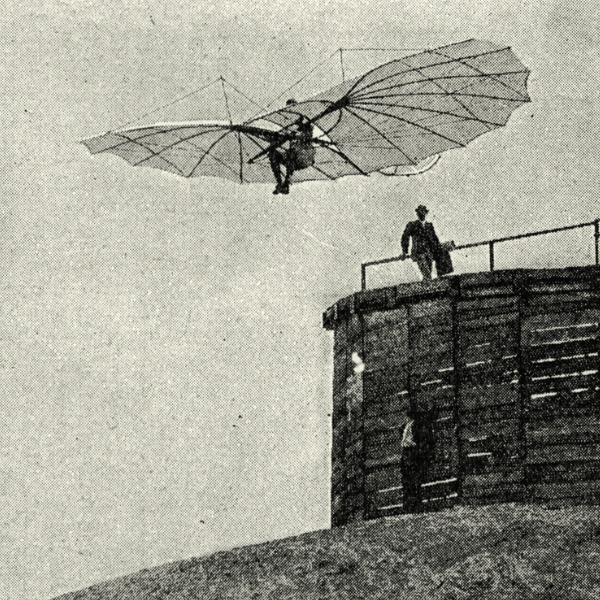
Otto Lilienthal's flying machine (duncan1890, iStockphoto)

Otto Lilienthal's flying machine (duncan1890, iStockphoto)
How does this align with my curriculum?
Learn how aviation pioneers from the world learned how to make humans fly!
Around the World - Early Ideas Take Flight
Perhaps they were inspired by soaring birds high in the sky. Perhaps they had other sources of inspiration. But it is true that humans have long wanted to fly themselves. We know this from ancient Greek mythology, such as the story of Icarus. In it, Icarus flew too close to the Sun and had the wax holding his wings together melt. There is also the story where Bellerophon the valiant captured Pegasus the flying horse. The Greeks were not the only ones interested in the freedom of the skies. In fact, there are stories and myths about flight in almost every corner of the world. For people in many cultures, stories of flying would connect them closer to their beliefs. They could allow them to do something that seemed impossible. Little did they know that one day, human dreams of flight would become a reality.
Africa
One such story is the tale of flying Africans. This story has been passed down through generations since slavery. It was about the quiet promise of freedom. The story helped people feel better during bad times, when they dreamed of one day returning home to Africa.

Image - Text Version
Shown is a colour image of a book cover for the book "The People Could Fly."
In the image, seven African people appear to be flying up into the sky. There are three men and three women as well as a baby of various ages. Their clothes are not fancy and in some cases look very worn out. An old man looks towards the viewer, while the others are looking in a variety of directions.
Japan
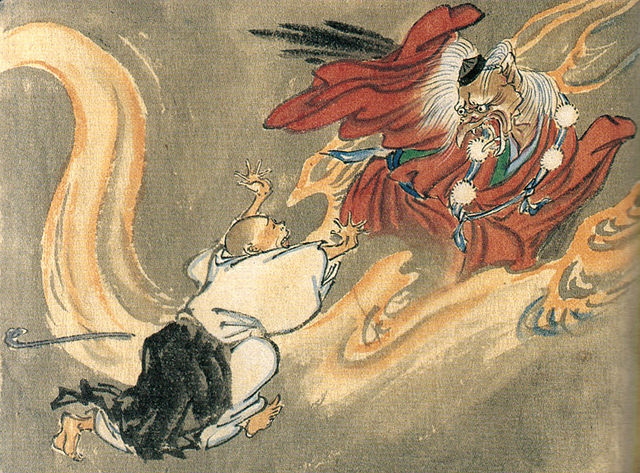
There are also historical records of man-lifting kites used in different countries. One story came from a Japanese outlaw and ninja by the name of Ishikawa Goemon (1558–1594). While tied to the tail of a giant kite, he stole the golden scales from the Nagoya Castle. He and his partners in crime were said to have stolen from the rich to give to the poor.
New Zealand
China
In ancient China, kites or ‘muyuan’ were used for and military purposes. Kites were both toys and practical devices for measuring things like distances and wind. They were also used for spying on enemy positions and sending urgent messages. Musical kites had bamboo pipes that would make sound when the wind moved through them.

Image -Text Version
Shown is a colourful traditional Chinese watercolour painting of an outdoor scene in ancient times. There are men sitting behind their desks under pergolas, a small group of children flying a kite, and several ladies standing off to the side.
Fly Like a Bird?
In the beginning, humans had no understanding of . They could only understand how things worked by using their observations and lots of . There were humans who thought that if they flapped their arms quickly enough they could fly. Others even strapped on homemade “wings” in the hopes of flying like a bird. Those early attempts did not usually end well….
One of the reasons for all these failures is the force of . Earth pulls everything down towards its centre. You know, “what goes up, must come down.” For humans to fly, we would need to find a way to overcome the force of gravity on our mass. In other words, people needed to find a way to create .
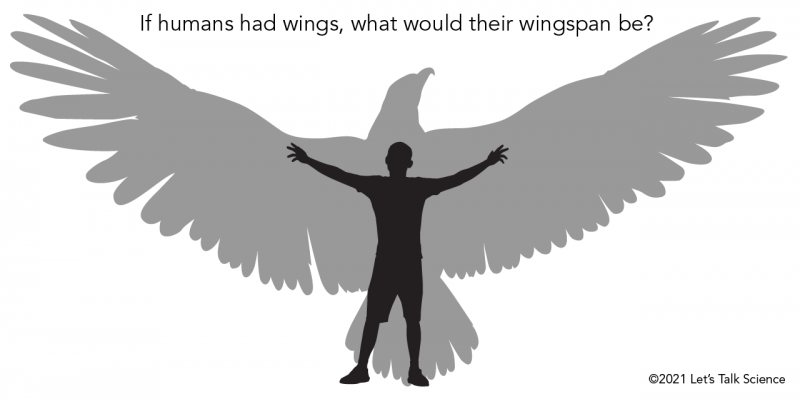
Image - Text Version
Shown is an illustration showing how big a wingspan a human would need in order to fly. In the background is the silhouette of an eagle with its wings outstretched. In the foreground is a human with their arms outstretched. The wingspan of the bird is about three times that of the person.
Did you know?
The Peregrine Falcon is the fastest animal in the sky. It has been measured at speeds of above 83.3 m/s (300 km/h) while diving. The world record human sprinter Usain Bolt’s fastest time is only 10.4 m/s (~37 km/h).
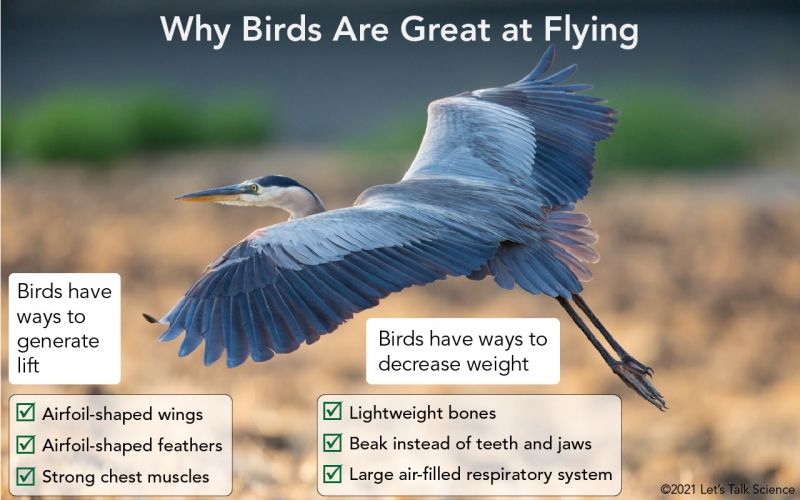
Image - Text Version
Shown is a colour photograph of a Great Blue Heron in flight. Overlaid on the image is text about how birds generate lift and decrease weight.
A Great Blue Heron is a large freshwater wading bird. It has long greyish blue feathers, long legs and a long neck with a large pointed beak for catching fish.
Near the head of the bird is text related to how birds generate lift. Birds generate lift because they have airfoil-shaped wings, airfoil-shaped feathers and strong chest muscles that are used to flap the wings. Birds decrease weight by having lightweight bones, a beak instead of teeth and jaws and a large air-filled respiratory system.
Generating Lift
Having a wingspan proportional to the size of one’s body is not the only thing that allows birds to fly. Birds have very strong muscles connected to their wings. Human chest muscles are not strong enough to lift our bodies into the air. They also did not have the endurance for something like flight. Unlike humans, birds also have feathers. A bird’s feathers catch the air and force it downward when they flap. This helps them create and push birds high up in the sky. Humans can jump in the air with the help of their legs, but staying in the air is a completely different story!
Reducing Weight
Birds have light-weight skeletons and hollow bones. This keeps their mass low. Air sacs inside their bodies also make them lighter than other animals of a similar size. A lighter object is easier to keep in the air than a heavier one.
Understanding the Four Forces of Flight
To make flying work, humans needed to master the four forces of flight. They experimented with lift by making kites and gliders and they looked for ways to use lightweight materials to minimise weight. They found ways to push or thrust planes and they explored ways to reduce drag, all in an effort to get off the ground. Human’s understanding of these forces would eventually allow them to take to the skies.
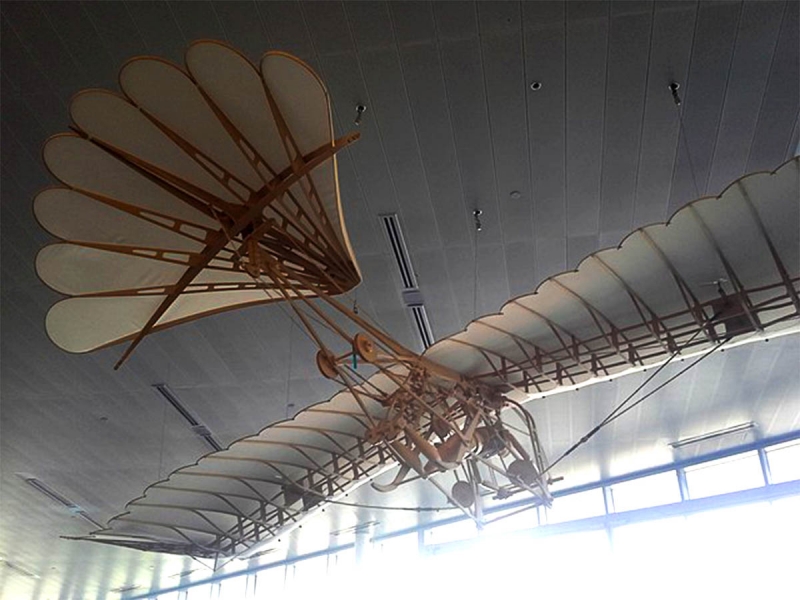
Image - Text Version
Shown is a colour photograph of an aircraft hanging from the ceiling in a large, brightly lit building
The aircraft is based on da Vinci's ornithopter, a structure with a wooden frame and a beige fabric shell. A wooden mannequin (pilot) is attached to the craft, facing downwards, just beneath the centre of the wings.
Did you know?
In 2013, a group of Toronto engineers won the Sikorsky Prize for designing a human-powered helicopter.
Fly Like a Kite
The invention of kites helped pave the way for human flight. But just how does a kite fly?
The force of wind pushes a kite upwards and backwards. In order for this to happen, the kite needs to be positioned at the right angle, which is known as the angle of attack. This angle enables the wind to move up and over the kite to create lift. The kite will move higher and higher as long as the lifting force is greater than the weight of the kite together with the lift-induced drag caused by angle of attack. Lift and drag work against each other, kind of like in a tug-of-war battle. Eventually, balance is reached between lift and drag so that the kite neither goes up nor down.
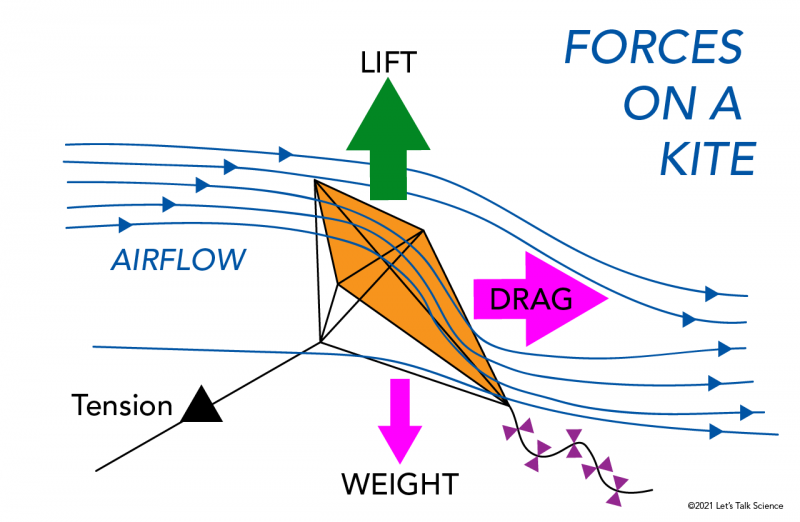
Image - Text Version
Shown is a colour illustration identifying how air flows around a kite in flight and the forces at play.
Blue lines identify the air flow which is parallel as it approaches the kite. The kite deflects the air both upward and downward creating life. Lift is identified using a green arrow that points upwards from the kite. The weight of the kite is identified by a pink arrow that is pointing downwards. Behind the kite the air is disturbed creating drag. This is identified using a pink arrow that points to the right, away from the kite. The kite strings are drawn with black lines. On the main kite string, is an arrow indicating that there is tension in the direction of the person holding the kite string.
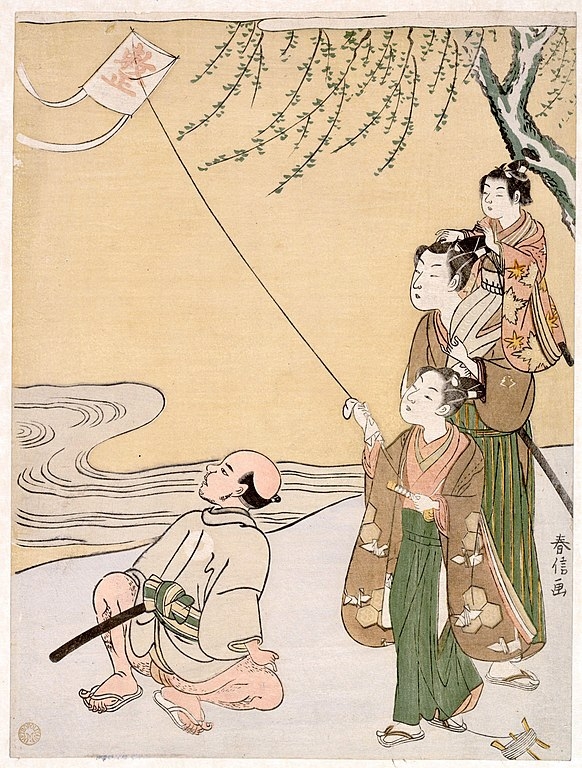
Image - Text Version
Shown is a historical colour woodblock print. In the print, a man is sitting on the ground watching while what appears to be a family of three is flying a kite. A child sits on the shoulders of the man and looks in the direction of the kite. The woman is flying the kit. We know this because the kite string is visible in her hands and the excess kite string is on a spool by her feet.
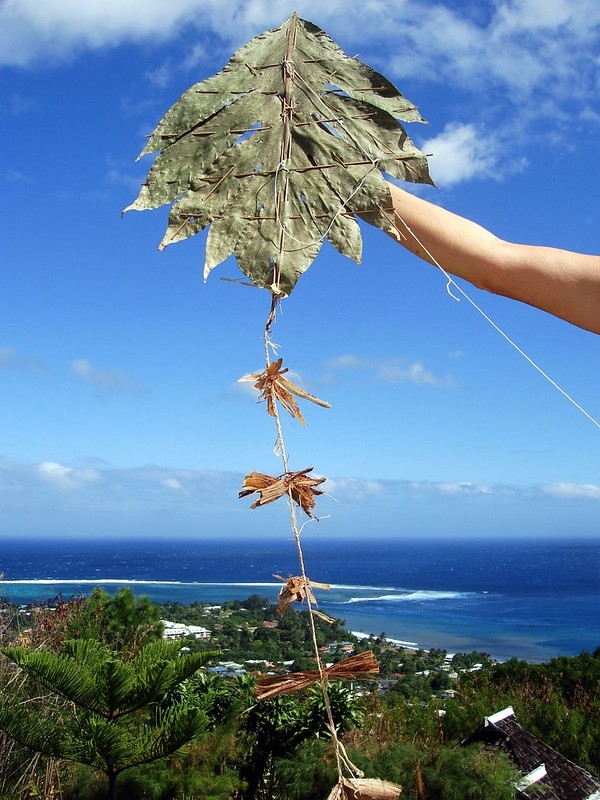
Image - Text Version
Shown is a colour photograph of a kite made from leaves. In the foreground is a hand holding on to the back of the kite. In the background is a hillside sloping down to a deep blue ocean in Tahiti. The main part of the kite has a diamond shape. It is made out of dried, flat breadfruit sleeves. The frame and cross pieces look like thin sticks. They are made from coconut leaf midribs. A string hangs down from the kite. Attached to it at intervals are clumps of brown banana tree bark.
To develop a kite for carrying humans, the structure had to change. British-born Australian explorer and inventor Lawrence Hargrave invented what is known as the box kite.
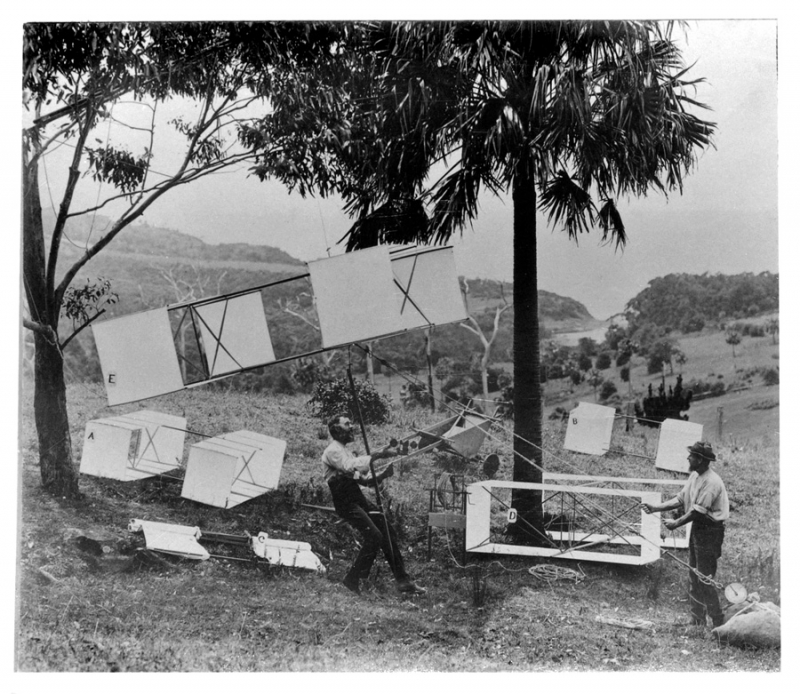
Image - Text Version
Shown is a historical black and white photograph of two men pulling on the strings of a box kite on a hillside beneath two trees. The men are preparing to connect the box kites together in preparation for an attempt at lifting a person.
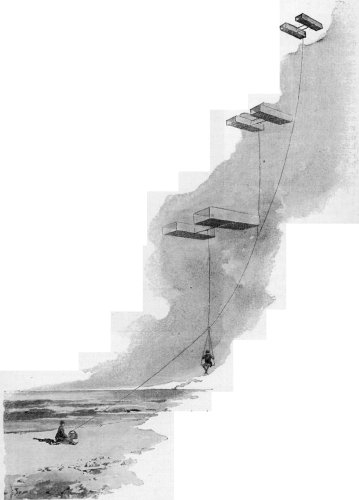
Image - Text Version
Shown is a black and white watercolour painting of Hargrave's test flight using kites as show in McLure's Magazine from 1896.
Sitting on a sandy beach is a man holding the reel of string that connects to the kites. Three pairs of box kites are seen in the sky, each at a different altitude. The kites are connected to each other with string. Hargrave, the inventor, is sitting in a chairlike swing suspended from the lowermost pair of box kites.
A few years later, Samuel Franklin Cody patented an improved version of Hargrave’s kite. To promote his kite to the Navy and the War Office for possible military use, he crossed the English Channel in a boat pulled by a kite. Known as Cody War-Kites, they were used by the British in World War I as a smaller alternative to balloons for spotting enemy .
Did you know?
Alexander Graham Bell, a Scotsman living in Canada, developed the tetrahedral kite. The same person invented the telephone!
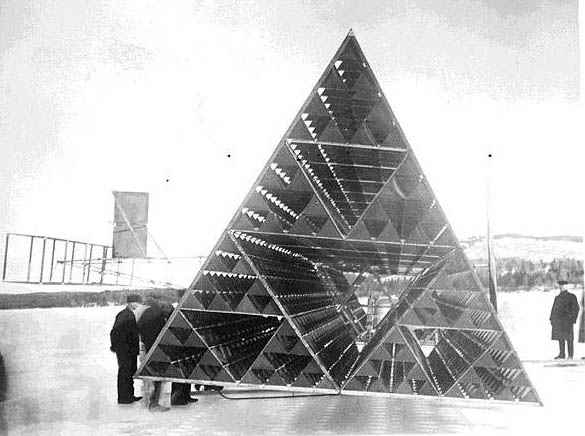
Image - Text Version
Shown is a historical black and white photograph of a small group of men looking at one of Alexander Graham Bell's large tetrahedral kites in 1909.
The kite looks like a large, 3D Sierpinski fractal. In other words, it is made of lots of large and small triangle sections arranged into one large triangle. Multiple layers of each flat cell are connected together to make the kite three-dimensional.
Lighter Than Air?
Once humans knew how important lift was to flight, they started to explore other ways to get lift. Airborne lanterns known as Kongming lanterns were used in ancient China to send military messages. Using balloons for lift would eventually make its way to the Western world.
Unfortunately, using balloons to carry people had a few drawbacks:
- A balloon goes wherever the wind carries it.
- The passengers have nearly no control over the speed or distance of their flight. So much for planning!
- There was no way to make it go in a given direction or steer it.
Modern dirigibles or blimps that carry people have propellers to push them and rudders and elevators to help control them.
The Birth of the Airplane
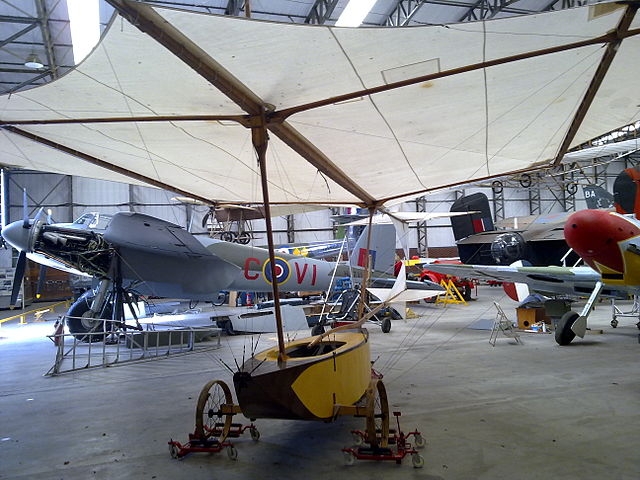
Image - Text Version
Shown is a colour photograph of George Cayley's glider inside the Yorkshire Air Museum.
The part where the pilot sits, the cockpit, looks a bit like a kayak. It is painted yellow and black. On the sides are two small wheels. Rising up from the cockpit is a wooden vertical post that looks to be about 2 metres high. Attached to this is a large wood and canvas structure that looks like a cross between a fancy kite and a hang glider sail.
Did you know?
The first recorded flight of a fixed-wing aircraft carrying an adult was when Cayley asked his reluctant coachman, John Appleby, to pilot a glider. He went on to glide for about 270 m over a valley.
For a period of over 50 years, Cayley made improvements to his gliders. He changed the shape of the wings so that the air would flow smoothly. And he added a tail to help make them more stable. He also eventually realized that the glider would need powered to travel longer distances. German pioneer of human aviation, Otto Lilienthal, also studied heavier-than-air flight. The Wright Brothers would credit him as their inspiration.
First Taste of Success
The Wright brothers, Wilbur and Orville, loved the mechanics of flying even as young children.
In 1900, the brothers travelled from Ohio to Kitty Hawk, North Carolina, to begin their flight experiments. The regular breezes and soft, sandy landing surfaces made it the perfect location for their test flights. Their first few weeks were very unsuccessful. But then they realized that the wings were not stiff enough. They decided to add some extra fabric to help stiffen the wings of the Wright Flyer. This did the trick!
Orville Wright took flight for 12 seconds on December 17, 1903. As Wilbur watched, Orville travelled just over 36 m before landing. Both brothers flew the airplane a few more times that day. History was made in the world’s first successful piloted powered aircraft.
Did you know?
Similar to hang gliders, the Wright brothers flew lying on their stomachs to reduce drag.
How did the Wright Flyer work?
The in the Wright brothers’ design converted spinning motion generated by the engine into forward motion. In other words, the propeller generated . The engine allowed the aircraft to move forward at a higher speed. This enabled air to flow rapidly over the wings. The fast airflow created an upward lift that overcame the plane's weight and kept it in the sky. The Wright Brothers concluded that it is the engine that moves a plane forward, while the wings move a plane upward.
Around the time of the Wright brothers’ first sustained flight, airplanes were being designed and tested all over the world. Countries like Chile, New Zealand and even Canada were well on their way.
Newer Heights
As you can see, it took a collective effort from humans around the globe to finally realize their dream of flying. Gradually, people gained a better understanding of how forces worked and how air behaved around objects. All of these developments would usher in the era of modern aircraft.
Learn More
Can You Flap and Fly?
A classroom activity from Science World examining the adaptations that allowed birds to fly.
A Matariki Story
A hands-on activity (2020) that walks the reader through the construction of a Matariki kite.
The Science of Flying a Kite
An article (2021) from Science ABC that discusses the forces involved in flying a kite.
Alexander Graham Bell Goes and Flies a Kite—for Science
An article (2021) from Scientific American that discusses the science involved in Alexander Graham Bell's experiments with kites.
How Do Airplanes Fly?
This video (3:10 min.) from Minute Physics discusses in detail the forces involved in getting a plane in the air and keeping it there.
Taking Flight with the Wright Brothers
An article (2015) from National Geographic Kids that looks at the life and times of the Wright Brothers
The Birthplaces of Aviation
This article (2009) looks at the other figures besides the Wright Brothers that contributed to humanity's ascent into flight.
History of Flight Around the World
This webpage from the AIAA shows the history of flight in a collection of selected countries.
References
Allison, S. N. (2019, March 7). Revisiting the Legend of Flying Africans. The New Yorker. Retrieved from https://www.newyorker.com/culture/culture-desk/revisiting-the-legend-of-flying-africans
Bibby, M. (2019, October 28). Sir George Cayley, the Father of Aeronautics. Historic UK: The History and Heritage Accommodation Guide. Retrieved from https://www.historic-uk.com/HistoryUK/HistoryofBritain/Sir-George-Cayley/
Cornish III, J. J. (1957). Go Fly A Kite. Natural History. Retrieved from https://www.naturalhistorymag.com/htmlsite/master.html?https://www.naturalhistorymag.com/htmlsite/editors_pick/1957_04_pick.html
Deachman, B. (2017, October 4). ‘I went flying because I wanted to fly, not to prove anything’: Canada’s first female fighter pilot honoured. Ottawa Citizen. Retrieved from https://ottawacitizen.com/news/local-news/i-went-flying-because-i-wanted-to-fly-not-to-prove-anything-canadas-first-female-fighter-pilot-honoured
Man-Vehicle Laboratory (1997). Theory of Flight. MIT Department of Aeronautics and Astronautics. Retrieved from https://web.mit.edu/16.00/www/aec/flight.html
Maxwell, E. (2018, July 27). Kite. Encyclopedia Britannica. Retrieved from https://www.britannica.com/topic/kite-aeronautics
NASA (n.d.). Forces on a Kite. Retrieved from https://www.grc.nasa.gov/www/k-12/airplane/kitefor.html
NASAexplores (2003, December 9). The Four Forces of Flight. NASA. Retrieved from https://www.nasa.gov/audience/foreducators/k-4/features/F_Four_Forces_of_Flight.html
National Balloon Museum (n.d.). History of Ballooning. Retrieved from https://www.nationalballoonmuseum.com/about/history-of-ballooning/
Needham, J. and L. Wang (1965). Mechanical Engineering. Science and Civilization in China: Physics and Physical Technology 4(2): 587
Neysmith, J. and Let’s Talk Science (2019, August 23). Soaring For Sport. Retrieved from https://letstalkscience.ca/educational-resources/stem-in-context/soaring-sport
Palmer, B. (2011, June 27). Humans want to fly like birds, but their bodies make it all but impossible. Washington Post, retrieved from https://www.washingtonpost.com/national/health-science/humans-want-to-fly-like-birds-but-their-bodies-make-it-all-but-impossible/2011/06/21/AGt1k7nH_story.html
Science Learning Hub (2011). Flight Mythology.
Victoria University of Wellington (2016). Kite Flown in War as an Act of Divination and of Magic. Games and Pastimes of the Maori. Retrieved from http://nzetc.victoria.ac.nz/tm/scholarly/tei-BesGame-t1-body-d6-d1-d3.html
Vintage Wings of Canada (2019). Black Buffalo. Retrieved from http://www.vintagewings.ca/VintageNews/Stories/tabid/116/articleType/ArticleView/articleId/342/Black-Buffalo.aspx
Wired (2020, Oct 13). Aerodynamics Explained by a World Record Paper Airplane Designer [video]. YouTube. https://www.youtube.com/watch?v=3KqjRPV9_PY